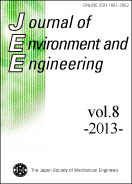This study proposes an idea of NOx reduction and high efficiency combustion by combination of burner and furnace. This is basically attributed to the use of entrainment of burnt gases to flame in furnace. The entrainment of burnt gases leads the dilution of flame and the recovery of heat to be exhausted. The phenomena are strongly related to the geometry of burner and furnace. The temperature, concentration, and flow field characteristics were investigated for piloted propane non-premixed flames in the cylindrical furnaces in terms of NOx emission. The effects of the furnace inner diameter,
D1, air inlet velocity difference,
ΔUa, and global equivalence ratio,
φ, on NOx emission were investigated. Moreover, two kinds of materials: Pyrex glass and stainless steel were used as the furnace wall to evaluate the radiation effect through the comparison of the flame characteristics. The emission index of NOx, EINOx, decreases roughly with the increase of above parameters. This decrease is observed to be a consequence of dilution by the burnt gases and flame stretch. The dilution is attributed to the recirculation structure, which is formed at the bottom of the furnace. The flame stretch is related to the velocity difference, which is introduced by multiple air inlets. The EINOx of confined non-premixed flame is scaled by the parameter
D1U
FΔUa, which is proportional to
Re,
cDa-1. Here,
UF is the fuel velocity,
Re,
c is the furnace Reynolds number reflecting the turbulence in the furnace, and
Da is the Damköhler number reflecting the flame stretch. The parameter
D1U
FΔUa is related linearly to the volume flow rate entrained in to the flame. Thus, this study verified that the EINOx of confined non-premixed flame is dominated primarily from the entrainment of burnt gases by the recirculation vortex and secondarily by the turbulence at the flame boundary, which is generated by the air velocity difference. In addition, it is found that under present experimental conditions, the radiation effect on the EINOx is small and constant with respect to the parameters. Thus, this idea has a potential for practical applications.
View full abstract
